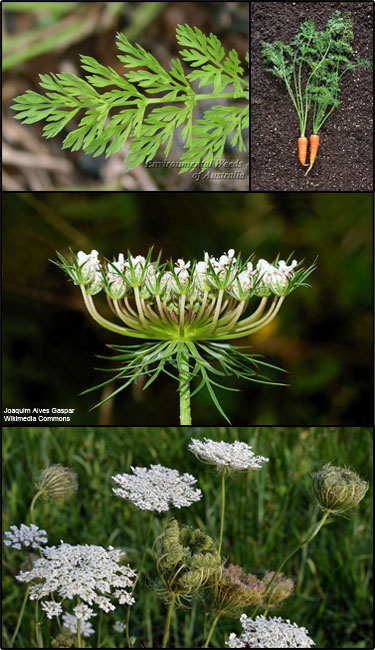Queen Anne's lace (Daucus carota)
 Common Names: Wild carrot
Common Names: Wild carrotDescription: Introduced to North America from Europe as a medicinal herb and is now naturalized throughout the continent. This species is listed under Regulation No. 715 - Seed Law Implementation as a restricted noxious weed by the Michigan Department of Agriculture.
Habit: Erect, herbaceous, biennial, grows 2-4 ft in height. Root system is comprised of a long slender white taproot and fibrous secondary roots. Roots may become woody with age and have a carrot-like odor and taste.
Leaves: Basal, alternate, pinnately compound with 1 to several finely divided, fern-like leaflets. Leaves increase in size toward the base of the stem and have a carrot-like odor. Basal rosettes remain green over winter. Upper leaves of second-year plants are stalkless with white sheathes at leaf bases.
Stems: Erect, hairy, hollow, grooved, branched at the top and may be reddish at the base.
Flowers: Small, 5 petaled, white in color and occur in a terminal, umbrella-shaped cluster at the ends of the stems. Produces a succession of flowering stalks until it dies with the first frost. Primary umbel curls inward representing a birds nest.
Fruit and seeds: Small brown fruits are dry and ribbed with bristly hairs. Fruits have hooked spines that attach to clothing or animal fur and aid in dispersal. One plant can produce 1,000 to 40,000 seeds.
Habitat: Native to Europe. Found in dry grasslands, fields, meadows, pastures, ditches, waste places, and railroad and highway right-of-ways.
Reproduction: By seed.
Similar species: Native American wild carrot (Daucus pusillus); Poison hemlock (Conium maculatum); Common yarrow (Achillea millefolium).
Monitoring and rapid response: Use gloves when handling this plant. Hand-pulling or mow close to the ground before seed set in mid to late summer. Effectively controlled using any of several readily available general use herbicides such as 2,4-D and triclopyr. Credits: The information provided in this factsheet was gathered from the U.S. Department of Agriculture, Forest Service.
Individual species images that appear with a number in a black box are courtesy of the Bugwood.org network (http://www.invasive.org).Individual photo author credits may not be included due to the small display size of the images and subsequent difficulty of reading the provided text. All other images appear courtesy of Google (http://images.google.com).
